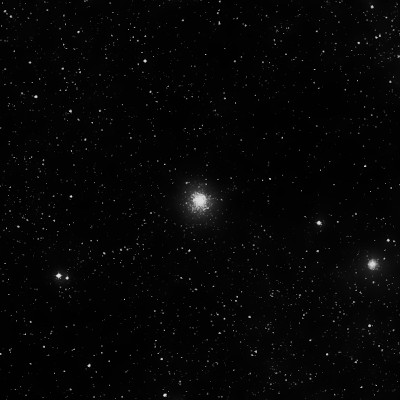
John Russell Hind discovered NGC 6760 = Au 44 on 30 Mar 1845 using a 7-inch Dollond refractor, while employed at George Bishop's private observatory in London. He reported "On the night of 1845 March 30, I found a faint nebula of a circular form... There does not appear to be any previous notice of this nebula, and Sir James South informs me that he can find no registered nebula within two degrees of this place. This somewhat singular as the present object was found while searching for comets with our 11 foot refractor."
Heinrich d'Arrest independently discovered the cluster in 1852 (announced in AN 809) while searching for comets with the 4.6-inch Fraunhofer refractor in Leipzig, though he later corrected his announcement. Arthur Auwers reported that in the 6" Heliometer it was "quite bright, R, gbM, 2-3' diameter." but once it was "surprisingly faint." At Birr Castle, Dreyer reported it as "vB, L, iR, vgpmbM, like a distant glob. Cl, although not distinctly resolved with the higher powers. eF curved branches go out from the south side."
John Herschel noted in the General Catalogue that this nebula was suspected of variability due to the widely disparate visual brightness estimates. A photograph was taken with the Mount Wilson 60-inch in 1914 due to comments about variability and the cluster was resolved into "1200 stars ranging approximately from 16.5 to 19.5 photographic magnitude...No trace of nebulosity is found."
200/250mm - 8" (6/22/81): faint, small, no resolution, very diffuse.
400/500mm - 17.5" (8/8/91): moderately bright, round, 3' diameter slightly elongated E-W, very mottled or granular appearance. A few very faint stars are resolved over the core and at the edge of the core. With averted vision the faint halo increases in size to 4' diameter. Several stars bracket the halo including a mag 13.5 star off the east edge. A rich mostly unresolved clump of extremely faint stars is close west.
600/800mm - 24" (8/12/15): viewed at 564x in excellent seeing and I was impressed with the resolution compared to previous views. The 2' core was extremely mottled and lively with roughly two dozen very faint stars popping in and out of view, but only a relative few constantly visible. Another couple of dozen stars were resolved in the halo, mostly in a 180° arc along the entire southern side. The stars along this arc are confined to a fairly thin strip that appeared detached from the core. Also a sparse string of stars extends northeast of the core.
Notes by Steve Gottlieb